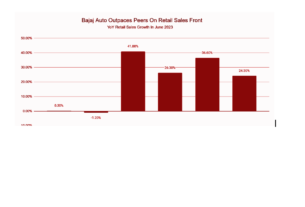Brent crude price has fallen more than 26% over the past one year. The government and central banks tangoed across all major economies to chain in inflation which led to oil’s downfall. High inflation reduces demand by eroding consumer purchasing power impacting every sphere of economic activity. Gross domestic product (GDP) growth rate of all major economies are either in the negative zone or in low single digits except India and China in Q1 2023.
All Major Central Banks Raise Interest Rates In June 2023
Bank of England (BoE) raised interest rates by 50 basis points (bps) to 5% on June 22, 2023. Both oil benchmarks, Brent crude and West Texas Intermediate (WTI) slid 1-2% immediately after BoE’s monetary policy announcement. Interest rates might increase further to 6% as the BoE tackles tough and sticky inflation, still high at 8.7%. But why does oil prices react to the US Fed or BOE or EU central bank’s interest rate decisions?
It’s not only oil prices, global stock markets, bond yields and various essential commodity prices that react to monetary policy decisions of central banks which control interest rate movements in their respective economies. In June 2023, the European Central Bank, BoE, Swiss central bank, Norwegian central bank, Bank of Canada, Reserve Bank of Australia, all raised interest rates. The Reserve Bank of India and the US Fed have paused interest rates hikes in their June monetary policy meeting. And all central banks except Reserve Bank of India have communicated that interest rate hike journey will continue till inflation is in control. But how does interest rate movement impact global crude prices?
Interest Rates Increase Leads To Low Crude Prices
As interest rates rise, companies borrow less as cost of capital increases, capital expenditure needs are curtailed, consumers spend less on housing, automobiles, consumer durables. Consumer spending is reduced as the cost of borrowing rises (banks increase interest rates on loans) and as a result economic growth slows down. As the economy slows down, the requirement of crude oil and its derivatives used in every economic sphere is reduced. There are other reasons also for the volatility in crude prices, such as supply disruption in an oil producing country, strategic output decisions taken by the Organization of Petroleum Exporting Countries (OPEC), or certain unforeseen events like the recent Russian mutiny which was short-lived. Though the Russian government was able to control the Wagner rebel group, the oil market was on tenterhooks as Russia is a major oil exporter with world’s fifth largest oil reserves.
India, major beneficiary of lower oil prices
India is a major oil importer and fifth largest economy in the world, lower oil prices is definitely good news. India is the fastest growing economy in the world at above 6% growth rate. Oil marketing companies (OMC) froze oil prices from November 2021 and continued till August 2022. Indian OMCs are expected to revise prices only after they recover last year’s losses. Hindustan Petroleum (HPC), Indian Oil Corporation (IOC) and Bharat Petroleum Corporation (BPC) are expected to reduce petrol and diesel prices in the near future. Lower oil prices aid lower input costs for every sphere of the economy for an oil guzzler like India. Cost of crude derivatives have reduced considerably over the past one year, helping various industries such as plastics, paints, and chemicals to name a few. Manufacturing sector and personal and commercial transportation will receive the requisite spur as oil prices will be reduced in the coming months before general elections. Indian current account deficit of Q12023 is already at 0.2% of GDP, lowest over the past four quarters. Though rise in non software exports and inflows helped, falling crude prices played a very significant role. No doubt, our benchmark indices, Nifty and BSE Sensex are on their lifetime highs.
Lower crude prices have given the requisite cushion to the RBI to tame inflation. Though the El Nino impact has already been felt with delayed monsoons, the healthy July-August rainfall and its distribution across the country will be good for the economy. Hopefully, the RBI should pause again in its August monetary policy committee (MPC) meeting.




